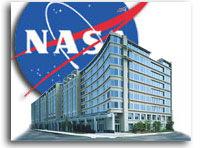NASA Strategic Management Council Meeting: Strategic Communication Framework

NASA Strategic Management Council Meeting Minutes and Actions 17 January 2007
Seventh Item of Business: Strategic Communication Framework
Assistant Administrator Robert Hopkins of the Office of Communications Planning presented an overview of his office’s efforts to development a framework to guide Agency communications.
– Hopkins described the process followed, summarized previous market research, and described a message architecture based on the vision and its central components: science, the economy, security and leadership.
– He presented potential messages and illustrated how they support the message architecture, and how the message can be briefly presented (e.g., the “elevator” speech).
– He stressed the need to bring audiences inside NASA and show them how NASA affects their lives.
– He described efforts to find new ways to communicate through building online communities, popularizing NASA through partnerships, and reaching policy-makers.
– He presented strategies for reaching different target audiences using different delivery mechanisms.
– He introduced a new message “platform”: the space economy, citing a speech made by Dr. John Marburger, the President’s Science Advisor.
– He closed by showing a schedule for market research leading to the creation of an implementation plan to be presented across the agency, and his plan to brief the communications framework to centers and mission directorate organizations.
Members discussed the need to know what audiences feel about NASA’s relevance to their lives. Ames Center Director Pete Worden suggested that to communicate with younger audiences, the Agency needs to better use the internet and new communications technologies. Chief of Strategic Communications Sterner told members about plans to form cells in the mission directorates that will be responsible to incorporate Agency messages into the communications efforts undertaken as part of mission activities. The goal is to “get everybody on the same page.” Sterner encouraged leaders to talk to their staff members who have responsibility for communications.
Aeronautics Research Associate Administrator Lisa Porter noted that the proposed messages are not framed in terms most people would use. Other members noted that there is a lot of human drama in NASA’s current programs but that the Agency doesn’t share those stories.
Griffin closed the discussion stating that it is vital to find ways to communicate the mystery and wonder of what NASA does.
SMC Action: Members will provide feedback on the Strategic Communications Framework to the Office of Communications Planning by the end of January 2007.
SMC Action: The Office of Communications Planning will include less abstract, more concrete messages in the testing planned to take place in February 2007 and report back at a subsequent SMC meeting.
Tenth Item of Business: Closing comments
Griffin made the following closing comments:
– He urged members to make intelligent decisions when determining where work is to be done – at a NASA center or by a contractor.
– He noted that except for three major programs, all NASA program managers are badged to center directors. He asked those center directors to help program managers at their centers look within NASA to place work before turning to contractors.
– He cited the presentation of the Strategic Communications Framework as being the most thought-provoking of the meeting. He stated that the effort is a place to start and that it will require support across the Agency.








